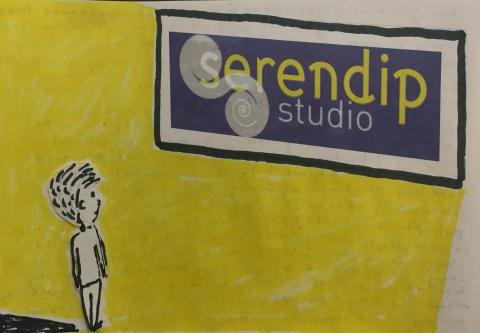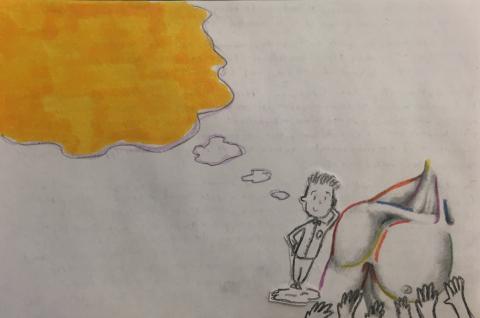April 24, 2016 - 14:49

Postcard #1 (1/26/2016)
“Learning communities are known to foster student engagement through collaborative learning as well as community- and problem-based learning. Students are taught to see connections among the courses they take, and community is a key condition for learning” (Rendón 39).
“We cling to notions of ‘independence’…as if it were an essential condition to all well-being” (Gorman).
The 360 Program at Bryn Mawr is undoubtedly one of the most cohesive and engaging offerings by the college. And while many of its benefits are academic, I only realized through a conversation with a friend this week how essential the personal connections have been to my learning. 360s are true learning communities, made up of a group of students already deeply passionate about a given topic. I have spent months of my life in these groups, and experienced enormous (seemingly unrelated) changes in my personal, non-academic life. To experience these changes at the same time as experiencing the support of community both within the walls of three classrooms and within an online community—whether I directly named my personal issues or not—did empower me. My life and studies were, in these moments, in harmony.
Postcard #2: (2/2/2016)
“You can affirm the authenticity of each human being—body, mind, heart and soul stretching into the fullness for which each of us is created” (Miller 20).
“At the same time, disability cultural environments have to safeguard against perpetuating or erecting other exclusions (based on racial stereotypes, class, gender, economic access, internalized ableism, etc.)” (Kuppers 4).
Throughout my life, I have shared many spaces with LGBTQ people constructed as healing and growing spaces—environments established with the intention to empower everyone who shows up. All too often, internalized homophobia and transphobia invade, and often in ways that I do not even notice at the time (these are the most damaging instances, as I am unknowingly vulnerable to restrictive and oppressive ways of thinking about myself and others).
Two days ago, I stumbled across an online crowdfunding campaign launched by a former mentor of mine. He and I had shared a space during a social justice program at a pivotal point in my life. Through his mere presence and a few simple words, he offered an environment in which I could grapple with parts of my identity that I had denied because they seemed to be conflicting. He affirmed my wholeness and encouraged me, through language and silence, to live in this paradox, to let it exist within me. He was a healing presence for me, and surely was for all those he knew in other parts of his life—I was not surprised to see that his fundraising goal had been met (primarily through many, many donations of $20 or less) in just two days.
Postcard #3 (2/16/2016)
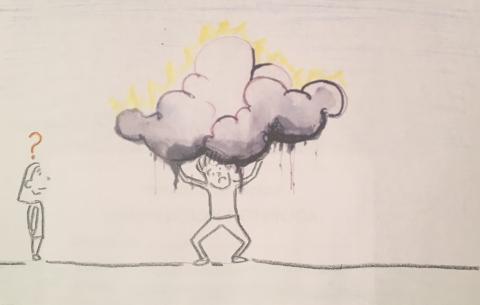
“It’s not a matter of the right choice of the wrong choice, but simply that we are often presented with a dilemma about bringing together the inspirations of the teachings with what they mean to us on the spot. There is a perplexing tension between our aspirations and the reality of feeling tired, hungry, stressed-out, afraid, bored, angry, or whatever we experience in any given moment in our life” – Pema Chodron, “Three Methods for Working with Chaos”
I’ve been thinking a lot lately about the guilt that circulates around communities of activists—the constant feeling of never doing “enough,” whatever “enough” really means—and the toxic comparison of how much people are doing to help out their community and others. Even within groups whose work seeks to challenge the dangerous and impossible norms set forth by society, there is so often an image of the ideal activist, the one who wants to help and does help more constantly and effectively, even and especially at the expense of their own comfort. I struggle to find myself in this image, and so frequently doubt my intentions as I work among marginalized populations through placements and internships. What does it say about me, about my essential goodness or lack thereof, if I don’t always look forward to going to my placement? If I feel sometimes that I would rather stay in bed than go to Haverford to work in the lab with participants from the center? I am so quick to question my whole purpose when I don’t feel a constant, overwhelming drive to be there.
But I realize as I read Chodron’s words that part of not seeing myself as a “helper” or “savior” is recognizing my own humanity, my own imperfections. I simply can’t put myself on a pedestal as I enter communities if I honor and work with my more “selfish” inclinations for rest or personal time—understanding where they come from, and through this recognition of imperfection, connecting on a person-to-person basis with community members.
Postcard #4 (2/23/2016)

Not being much of a visual artist myself, I didn’t come into my placement at the center with a particular passion for the art itself—though I was excited about what I knew art could add to a relationship in the way of communication, self-expression, and representation, I was still hesitant about my relationship to the form that the artists at the center center their life around. Each and every one has their own very developed style, and their personhood is expressed so clearly in each piece I have seen. This week, though, I had the opportunity to connect with one participant, Carl*, on music. While walking to the lab, I asked him if he could whistle—he did, and we whistled together for a while. When I asked if he knew how to beatbox, he surprised me by immediately breaking out some impressive vocal percussion skills. Later, another Bryn Mawr student informed me that Carl* was a great singer, and had helped record an album with other participants at the center. We listened to some tracks, and Carl* even sang me a part of “Amazing Grace” on the spot. There was something so unique and special about this experience for me—because my artistic passion lies in music, so much of the way that I come to understand those around me and their individuality is through their voices and how they use them. I learned so much about Carl* that day that could not be put into words or added into a dialogical conversation.
The moment really harkened back to Kuppers for me, and immediately deepened my reading. Quoting Iwana in her analysis of the performance art she experiences, Kuppers writes that one of the goals of the shared practice is “extricating the pure life which is dormant in our bodies” (Iwana, qtd. in Kuppers 115). The power of any kind of art to offer alternative communication pathways is astounding, but I didn’t realize the extent of these possibilities until the artistic language I have the most experience with—music—was spoken.
Postcard #5 (2/29/2016)
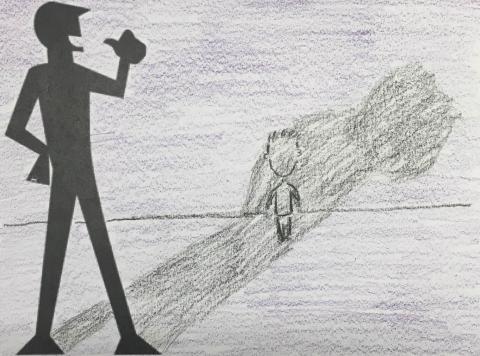
"There can be no love without justice. Until we live in a culture that not only respects but also upholds basic civil rights for children, most children will not know love. In our culture the private family dwelling is the one institutionalized sphere of power that can easily be autocratic and fascistic. As absolute rulers, parents can usually decide without any intervention what is best for their children. If children's rights are taken away in any domestic household, they have no legal recourse. Unlike women who can organize to protest sexist domination, demanding both equal rights and justice, children can only rely on well-meaning adults to assist them if they are being exploited and oppressed in the home" (hooks 19-20).
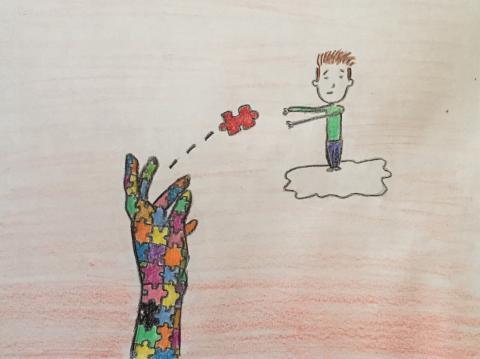
“In virtually all my interviews, guilt was the elephant in the room [. . .] 'Bad conscience' can become ‘torture without end,’ undoing any prospects for happiness” (Sherman 2010).
Thinking on guilt as it relates to trauma in the classroom, my first mental move was to break down what I consider guilt to be: the internal privileging of what one has deemed their wrongdoings or “bad” parts over the good—even if only for a moment. Surely, there are times when guilt is important, and it alerts us to when we should take actions (apologizing or making up for something)—and then, sometimes, there is nothing to be done except move forward. Thinking about guilt as an emotional burden that someone with trauma lives with longterm, how can educators create an environment that might ease that burden for learners?
I am, as always, brought back to the 360 Program, perhaps because I consider it to be such a community space where learning and emotional lives intermingle in powerful and productive ways. The 360s in which I have participated allow students to simultaneously exercise and exhibit multiple parts of themselves (as theoretical scholars, as people with multiple, intersecting identities and personal stories, and even as artists). Coming into the classroom bringing parts of ourselves that are not so often valued in school allows others to see us people with *complex personhood*—and by extension, allow us to see ourselves that way.
When we see so many parts of ourselves at once, we must find some goodness, it seems, and with the recognition of that goodness may come some forgiveness—it also may allow us to see that the parts of ourselves of which we are less proud can and do coexist with our goodness, that this paradox is part of our humanity. Ultimately, it seems, 360 clusters all us to see that we need not necessarily abandon our disappointment in ourselves in order to accept and respect ourselves.
Last semester, learning about the experiences of women in women’s prisons who participate in book groups, I found that this entire perspective comes with a great deal of privilege. We read many accounts of women for whom it was remarkably important to define themselves as a new person—distinct from the people they were before their prison sentence.
“That self-judgment and sense of responsibility, even guilt, may even be redemptive, a way of reconnecting with one’s full humanity. The soldiers I spoke with longed for a way to feel whole, even if at the cost of their profound and acute feelings of guilt” (Sherman 2010).
I am, of course, in no position to interrogate this need, and know that the experiences I bring to bear to the conversation do not have the same gravity (I have never had to question whether my entire life path--and resultantly, identity--should have to change in order for me to move forward).
Postcard #7 (3/29/2016)
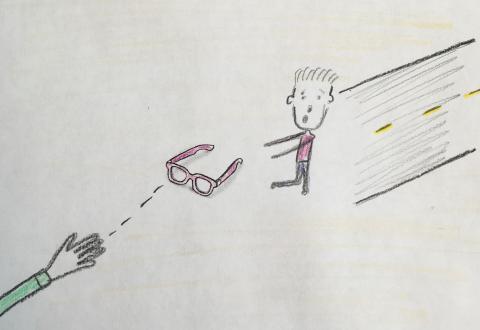
Quoting M. Scott Peck, bell hooks defines love as “the will to extend one’s self for the purpose of nurturing one’s own or another’s spiritual growth [. . .] Love is as love does. Love is an act of will—namely, both an intention and an action. Will also implies choice. We do not have to love. We choose to love” (hooks 28-29).
I have been thinking deeply about the role of love in teaching, particularly in a conventional classroom setting because the education system seems established in such a way that it is a uniquely hostile space for love. So often, teaching and learning are established as two sides of binary, and teachers are sked to enter a classroom defensive of their role as an expert, unwilling to identify and explore the spaces where they could (and should) be a learner.
Peck’s (and hooks’) definition of love asks that the lover makes the conscious decision to “extend one’s self,” a reaching for more which feels very much like Appadurai’s definition of researching to gain knowledge—an idea which I feel could here be used interchangeably with learning. Someone who loves must be willing to learn for the very purpose of their loved one’s ability to grow and learn themselves. As Moll, Amanti, Neff, and Gonzalez write in their piece on funds of knowledge for teaching, the visits made by eachers to students’ homes “are neither casual visits nor school-business visits, but visits in which the teachers assume the role of the learner, and in doing so, help establish a fundamentally new, more symmetrical relationship with the parents of the students” (139). This, to me, feels very much like an exercise of love for the learner, a moment in which the teacher goes above and beyond expectations, working in tandem with parents to show love for the students in their classroom.
Postcard #8 (4/5/2016)
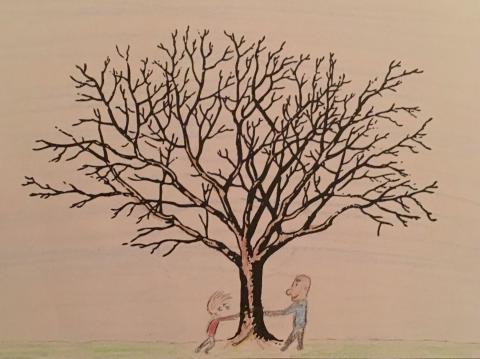
“The capacity to do research, in this broad sense, is also tied to what I have recently called ‘the capacity to aspire’ [. . .], the social and cultural capacity to plan, hope, desire, and achieve socially valuable goals. The uneven distribution of this capacity is both a symptom and a measure of poverty, and it is a form of maldistribution that can be changed by policy and politics” (Appadurai 176-77)
Often, when people become parents of children with intellectual or developmental disabilities, they feel that their dreams—what they have always wanted for their child—have been crushed. Surely their children can have no future—and because people with intellectual disabilities face infantilization throughout their lives, many live in perpetual states of futurelessness. After high school, education ends for most adults with intellectual disabilities. Expanding the horizons of their knowledge is simply not considered valuable, and many are considered “unteachable.”
Last week, we traveled to Haverford’s campus with artists from the center to do some research. Since we were using white oak wood to build our boxes, we decided to learn more about the white oak trees that are so common on the campus. We measured them to determine their age and height, and drew them while seeing them in person. In my field notes, I expressed the strong feelings of connection that I felt in this moment. The center was creating a space where adults could constantly exercise their right to aspire—by offering them the chance to learn through and about an engaging artistic project.

